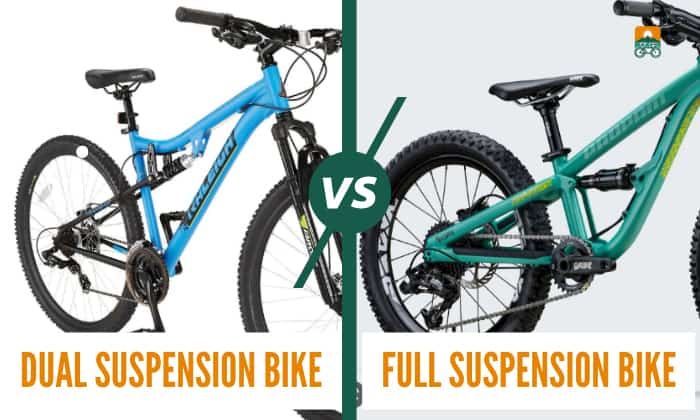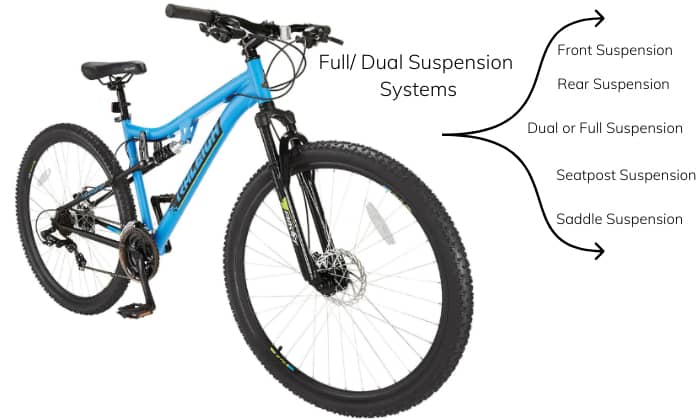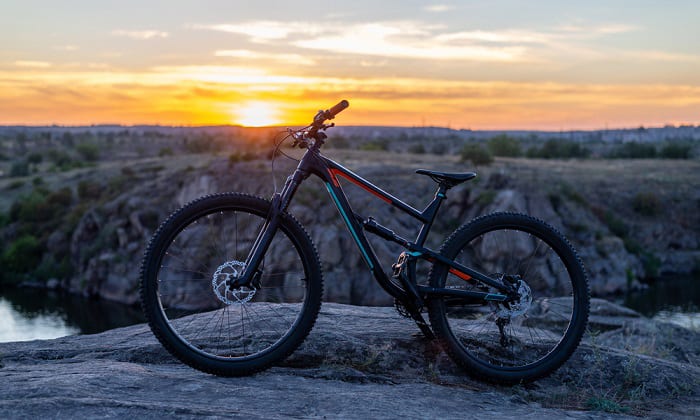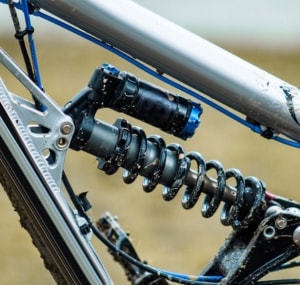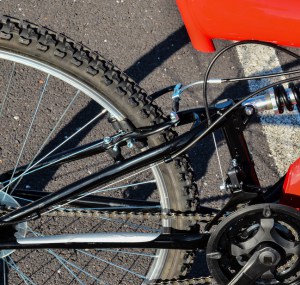Dual vs Full Suspension Bicycles: Sound Different, But Actually The Same
Bikes are one of the simpler vehicles with no engines or intricate mechanisms. You hop on, peddle, and the bicycle sails away. However, once you get into information and choices for parts, things may get a little confusing. Take the dual suspension vs full suspension options for example.
While it may seem complicated to distinguish the two, it’s actually not. Both refer to the same thing: bicycles with suspension for both front and rear.
Table of Contents
Full and Dual Suspension Systems Are One
Just like any other vehicle, bicycles have suspension systems and there are different types of bike suspension. Common implementations of bike suspension are:
- Front Suspension: refers to cycles with suspension systems at the front only
- Rear Suspension: refers to cycles with suspension systems at the rear only
- Dual or Full Suspension: refers to cycles with suspension systems at the front and rear.
- Seatpost Suspension: refers to cycles with a suspension system implemented to the seat post.
- Saddle Suspension: refers to cycles with a suspension system implemented to the saddle
So, asking “What is a dual suspension bike?” is the same as “What is a full suspension bike?” Both full and dual suspension means the same thing: installed at the front and back of a bicycle.
A bike can have just one suspension system or multiple in conjunction with each other. For instance, dual/full suspension bicycles combine front and rear suspensions, while the hardtail only has suspension at the front side, leaving the rear rigid.
Overview of Dual/Full Suspension
Now that we know bicycle dual suspension and full suspension refer to the same thing let’s see why it’s important for your bike.
1. Purpose
This system allows you to retain control when subjected to the impact of bumps or rough terrain. The suspension mechanism absorbs shocks from hitting obstacles so your body doesn’t have to, enabling a smooth riding experience.
2. Working mechanism
A full suspension mountain bike has a shock absorber for both the front and the rear to stabilize both wheels. It would be easy to assume some sort of spring is installed on each side, and while this is technically correct, they’re quite different from one another.
3. The fork
One of the most common suspensions used in bikes is the fork. You often see it in the front suspension, connected to the steer tube and slots into the frame. You’ll also notice that the wheel connects to it, and it’s also where the disc brake mounts if you have one.
The fork is made up of two stanchions, one on each side of the front wheel, and they have sliders at their lower end. When the bike encounters some impact, the stanchion shifts into the slider to provide shock absorption using a steel spring or an air chamber and allows the wheel to adjust.
The distance that the stanchions move differs between types. Short-distance types are often used for multi-purpose cycles. In contrast, long-distance ones are usually found on bikes for rough terrain, such as downhill courses.
4. Rear suspension
The rear suspension is a bit more complicated because of the number of variations that exist and is characterized not only by its main shock but also by its pivots. However, it functions similarly to the fork, with compression distance and wheel movement still being primary considerations.
The shock resembles the mechanism found on the fork, but the rear suspension typically has one unit. It can be situated differently on the fork and may be oriented horizontally or vertically, depending on its design.
5. The pivot
The pivot refers to the point of movement built into the bicycle, which allows the shock to work. The simplest design uses a single pivot, but others use multiple pivots to offer better shock absorption and cope with more severe impact. Some designs use the pivot to connect the frame to another structure, such as a twin-link suspension.
Pros and Cons of Dual Suspension Bikes
- Excellent stability even on bumpy tracks
- Capable of taking on high jumps and drops
- Provides superior traction along with a damping system that allows the wheel to roll over obstacles
- Comfortable to ride
- Require frequent maintenance
- Lose power due to shock compression making them inefficient
- Heavier due to additional load of suspension components making them slower
- Expensive
Dual Suspension Vs Front Suspension: Which is Better?
We already know how important it is to have shock systems on a bike but after looking at what it has to offer, is dual suspension worth it? To answer the question, let’s compare full suspension to hardtail.
- Hardtails are recommended for beginner cyclists as they are easier to use and maintain.
They’re more efficient because they transfer power from the pedals directly to the rear wheel. Since the extra weight of additional shocks does not bog them down, they are faster during climbs and on clear tracks.
- On the other hand, full suspension is necessary for riding on tracks with many jumps or drops. They’re also useful when tackling rocky or bumpy tracks since they reduce the risk of crashing with their higher traction and better handling.
The bottom line is that hardtails offer more versatility as they provide a more standardized riding experience across various terrain. Full suspension systems provide more customizability, better style, and a more comfortable riding experience.
Which one is right for you? It depends on your preference and experience. Think about the terrain as well as what’s more comfortable for you.
- Pick hardtail bikes if you’re a newbie who’s just getting into cycling.
- Seasoned cyclists may prefer dual suspension for more challenging courses.
Frequently Asked Questions
How much does a bike with dual suspension cost?
The price of a full-suspension MTB varies a lot. It depends on the quality of the components, and the suspension system is just one contributor. However, high-end models with quality shock-absorbing mechanisms will fetch a much higher price.
A cheap dual suspension mountain bike around $500 will need to make concessions to lower prices to such a degree. You can get a properly functional model until you reach the price range of $1000.
Expect to spend around $2000 or more for a decent full-suspension MTB. To save some bucks, you can get a used full suspension mountain bike for $800. Brand new premium models reach up to and over $10000, offering features on such a build would be hard to match.
Are there full-suspension road bikes?
Yes, there are suspension systems on road bikes but these are rare, and full-suspension setups are even rarer. If you refer to our list of cons for dual-suspension systems, inefficiency is a big problem. This is a glaring issue when it comes to bicycles designed for speed.
However, there still are full-suspension road bikes, but many are also custom. You’re also likely to find that the suspension used is different from those found on a dual suspension MTB. Shocks may also be used.
Conclusion
Now you know all about dual suspension vs full suspension on a bicycle and that they’re the same thing. All that’s left is to weigh everything they offer and decide whether they fit your needs.
Have you used both types of suspension on bikes? Which type do you prefer and why? Tell us your thoughts and opinions in the comments section below.

“I ride my bike to work for years, but is that enough? Our carelessness towards our surroundings has taken a toll on the environment. And now, everyone is responsible for changes; even the most minor contribution is counted. With this hope and spirit, I started with my partner to establish Biketoworkday to help more individuals commute to their work sites on their bikes.”

